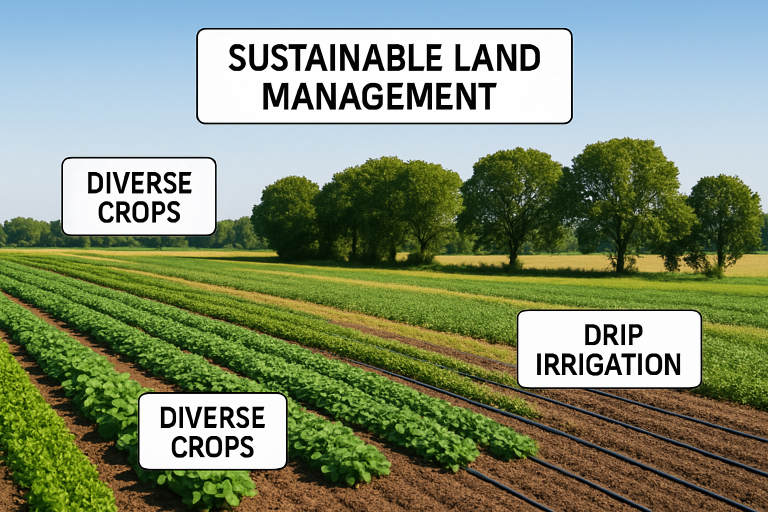As demands on food production grow and environmental pressures rise, sustainable land management is essential for today’s farmers. It focuses on long-term viability, soil and water quality, and biodiversity. Embracing these strategies helps farmers lower costs, reduce risks, and ensure resilience. Farmers face challenges like climate change, market shifts, and regulations. Science-driven sustainable practices address these issues and promote productivity and conservation. Sustainable land management benefits rural communities by boosting local economies, improving water management, and encouraging stakeholder cooperation.
Enhancing Soil Health
Soil health is the cornerstone of sustainable agriculture. Healthy soils are rich in organic matter, host beneficial microorganisms, and possess a structure that retains nutrients and moisture. Methods such as crop rotation, cover cropping, and conservation tillage protect soil structure and support natural nutrient cycles. By rotating crops with legumes, for example, farmers can naturally enrich soils with nitrogen, reducing dependency on synthetic inputs and lowering environmental risks. The USDA’s partnership with farmers has demonstrated that integrating these practices increases the soil’s resilience to both drought and excessive rainfall, ultimately boosting the long-term value of land for sale Iowa for both productivity and sustainability.
Water Conservation Strategies
Water is one of farming’s most precious resources, and its availability is increasingly unpredictable. Implementing water conservation approaches—such as rainwater harvesting, micro-irrigation, and mulching—not only improves efficiency but also reduces costs and energy consumption. Drip irrigation, for instance, delivers water directly to plant roots, thereby limiting evaporation and increasing yields. Such targeted watering methods can save up to 60% more water compared to traditional overhead irrigation systems.
Implementing Agroforestry
Agroforestry blends agricultural and forestry principles by incorporating trees and shrubs alongside crops or livestock. This integration not only increases biodiversity but also provides shade, reduces wind erosion, and stabilizes the microclimate for crops. Moreover, trees offer complementary revenue opportunities—such as fruit, nuts, timber, or honey. Studies from major land-grant universities highlight how these systems buffer farms against market volatility while enriching ecosystems and improving livelihoods.
Precision Agriculture Technologies
The advent of digital technology has transformed traditional farming into a data-driven industry. Precision agriculture employs GPS-guided machinery, remote sensors, and aerial drones to enable farmers to monitor and respond to crop and soil variability. For example, drones equipped with multispectral cameras can identify stressed crops, guide targeted applications of nutrients, and avoid unnecessary chemical use—saving money and reducing runoff into waterways. This approach ensures inputs are applied with pinpoint accuracy, maximizing efficiency and environmental protection.
The Role of Farmer Cooperatives
Cooperatives unite farmers to achieve economies of scale, access shared resources, and leverage market power. Collectively, these organizations can invest in sustainable infrastructure, promote knowledge sharing, and secure better prices for members’ goods. Cooperative models have been particularly effective in implementing sustainability certifications, pooling resources for advanced machinery, and securing group insurance or financing for conservation measures.

Adopting Regenerative Agriculture
Regenerative agriculture advances beyond sustainability by actively restoring degraded soil health, biodiversity, and ecosystem services. Common practices include composting, the use of diverse cover crops, rotational grazing, and reduced tillage. These actions rebuild soil organic matter, increase water infiltration, and enhance carbon sequestration. Many pioneering farmers report increased yields and higher farm profitability after several seasons of regenerative practices.
Policy Support and Incentives
Effective public policies and targeted incentives can help accelerate the adoption of sustainable land management techniques among farmers. Governmental cost-share programs, environmental grants, tax incentives, and technical support play vital roles in making the transition feasible. These incentives are significant for early adopters who face steep initial investment costs. Policy frameworks that encourage risk management, research and development, and support for conservation easements are crucial for fostering scalable, long-lasting impact.
Conclusion
The adoption of sustainable land management practices is essential for preserving the agricultural productivity and environmental vitality of farm landscapes. Farmers who invest in restoring soil, conserving water, leveraging technology, and joining cooperative efforts pave the way for resilient, future-ready operations. By harmonizing productivity with stewardship, modern farmers are redefining what it means to succeed in agriculture and sustain resources for future generations.
“In a world of instant takes and AI-generated noise, John Authers writes like a human. His words carry weight—not just from knowledge, but from care. Readers don’t come to him for headlines; they come for meaning. He doesn’t just explain what happened—he helps you understand why it matters. That’s what sets him apart.”

